Agro Metrology
Agro Metrology
This station was established in the year 1905 by the Department of agriculture U.P. as a seed multiplication farm. In the year 1944, this farm was converted in to a Research Station with the responsibility of cotton research entrusted to the Assistant Economic Botanist (cotton). The status of this research station was further raised during 1951 to the main Cotton Research Station with post of economic Botanist (Cotton and Tobacco). In May 1973 this research station was transferred to G.B. Pant University of Agriculture & Technology, Pant Nagar and multidisciplinary research work on important field’s crop of the region was carried out. After the division of the Uttar Pradesh this station was transferred to S.V.P. University of Agriculture & Technology, Meerut in October, 2000.
Land Allocation
Total Area of the Centre 10.000 ha.
(i) Area under Layout, Buildings and channels 01.856 ha.
(ii) Area under cultivation 08.144 ha.
Total 10.000 ha
- 2. Research Mandate
- Experimental trials on varietal evaluation.
- Trials to evaluate effectiveness of agrochemicals.
- Trials to evaluation of different agricultural practices/ technologies.
- Demonstration of technologies.
- Seed production.
- 3. Technologies developed and recommendations.
- Regional Research Station, Bulandshahr have a very good collection of cotton germplasm comprising 242 germplasms of desi cotton and 162 germplasms of American cotton.
- Prominent desi cotton varieties namely Lohit and Shamli were released from Regional Research Station, Bulandshahr.
- National Agricultural Research Project (NARP II) funded by world bank was functional ar Regional Research Station, Bulandshahr from year 1990-94. Under this project cropping syatem adoption/modification studies were conducted and its finding have immensely contributed in the change of cropping pattern in Bulandshahr district.
- Under Graduate programme RAWE students were entertained at Regional Research Station, Bulandshahr and under supervision of Regional Research Station, Bulandshahr scientists they completed their respective assignments.
- 4. Activities of Regional Research Station Bulandshahr
- a. Research trials under AICRP, Station Varietal Trials, NIVT, AVT, Era-Trial are conducted in cotton wheat and paddy crop.
Year |
Season |
Crop |
Title of trial |
2017 |
Kharif |
Cotton |
Evaluation of Desi cotton germplasms |
Evaluation of American germplasms of cotton |
|||
Paddy |
Effect of different doses of water soluble fertilizers on yield /productivity of different cultivars of paddy. |
||
Effect of age of nursery and distance of planting on rice crop in SRI method. |
|||
Yield maximization in basmati rice through nutrients management. |
|||
2017-18 |
Rabi |
Wheat |
Trial to study the effect of fertilizers application and method of sowing on wheat crop |
Trial to assess effect of Poly-4 (polhalite) on potato crop for K, S use efficiency in soil |
|||
Testing of 40 wheat germplasm for different parameters |
|||
All India co-ordinated wheat NIVT, AVT, RI, Late Sown and very late sown trials. |
|||
2018 |
Kharif |
Cotton |
Evaluation of Desi cotton germplasms |
Evaluation of American germplasms of cotton |
|||
Paddy |
Effect of age of nursery and distance of planting on rice crop in SRI method. |
||
Yield maximization in basmati rice through nutrients management. |
|||
2018-19 |
Rabi |
Wheat |
Trial to study the effect of fertilizers application and method of sowing on wheat crop |
Testing of 40 wheat germplasm for different parameters |
|||
All India co-ordinated wheat NIVT, AVT, RI, Late Sown and very late sown trials. |
|||
Trial to study the effect of fertilizers application and method of sowing on wheat crop |
|||
Potato |
Trial to assess effect of Poly-4 (polhalite) on potato crop for K, S use efficiency in soil |
||
2019 |
Kharif |
Cotton |
Evaluation of Desi cotton germplasms |
Evaluation of American germplasms of cotton |
|||
Paddy |
Experiment on weed control measures in paddy crop |
||
2019-20 |
Rabi |
Wheat |
All India co-ordinated wheat NIVT, AVT, RI, Late Sown and very late sown trials. |
Trial to study the effect of fertilizers application and method of sowing on wheat crop |
|||
Potato |
Trial to assess effect of Poly-4 (polhalite) on potato crop for K, S use efficiency in soil |
||
2020 |
Kharif |
Cotton |
Evaluation of Desi cotton germplasms |
Evaluation of American germplasms of cotton |
|||
Paddy |
Experiment on weed control measures in paddy crop |
||
Effect of dose and time of fertilizers on rice crop for yield and attributing traits |
|||
Studies on effect of weed control measures on the performance of rice variety Pusa-1509 |
|||
2020-21 |
Rabi |
Wheat |
All India co-ordinated wheat NIVT, AVT, RI, Late Sown and very late sown trials. |
|
Trial to study the effect of fertilizers application and method of sowing on wheat crop |
||
2021 |
Kharif |
Cotton |
Evaluation of Desi cotton germplasms |
Evaluation of American germplasms of cotton |
|||
Paddy |
Experiment on weed control measures in paddy crop |
||
2021-22 |
Rabi |
Wheat |
All India co-ordinated wheat NIVT, AVT, RI, Late Sown and very late sown trials. |
b. Demonstration of advance crop production technologies and varieties.
c. Seed production programme of latest varieties of rice, wheat, berseem and pigeonpea etc.
S.No. |
Crop |
Variety |
Area (Ha) |
Total Production (Q/ha) |
Productivity (Q/ha) |
Rabi 2016-17 |
|||||
Wheat |
DBW-88 |
0.34 |
16.46 |
48.41 |
|
HD-2967 |
2.44 |
134.37 |
54.97 |
||
HD-3086 |
2.16 |
89.92 |
41.62 |
||
DBW-71 |
0.6664 |
33.60 |
50.60 |
||
PBW-226 |
0.536 |
28.00 |
52.23 |
||
Kharif 2017 |
|||||
Paddy |
Pusa Sugandh-5 |
0.80 |
25.60 |
32.00 |
|
Pusa Basmati-6 |
1.164 |
28.10 |
24.14 |
||
Pusa Basmati-1509 |
0.40 |
17.25 |
43.12 |
||
Rabi 2017-18 |
|||||
Wheat |
DBW-88 |
1.3 |
68.40 |
52.61 |
|
HD-3086 |
0.80 |
36.80 |
46.00 |
||
HD-2967 |
2.64 |
140.80 |
53.44 |
||
DBW-71 |
0.96 |
40.80 |
42.54 |
||
DBW-17 |
0.844 |
36.40 |
43.12 |
||
Kharif 2018 |
|||||
Paddy |
Pusa -1509 |
0.80 |
27.10 |
33.87 |
|
|
Pusa Sugandh-5 |
0.80 |
27.90 |
34.87 |
|
|
Pusa-1612 |
0.80 |
22.65 |
28 |
|
|
Pusa-1121 |
0.404 |
11.15 |
|
|
Rabi 2018-19 |
|||||
Wheat |
DBW-90 |
0.74 |
39.30 |
53.10 |
|
DBW-17 |
0.40 |
22.33 |
55.82 |
||
DBW-88 |
0.80 |
46.00 |
57.50 |
||
DBW-71 |
0.80 |
45.33 |
56.66 |
||
HD-2967 |
3.404 |
167.26 |
49.13 |
||
Kharif 2019 |
|||||
Paddy |
Pusa Sugandh-5 |
0.40 |
15.30 |
38.25 |
|
Pusa-1509 |
0.60 |
21.50 |
35.83 |
||
Pant Basmati-1 |
0.80 |
32.20 |
40.25 |
||
Pusa-1121 |
0.864 |
20.90 |
24.18 |
||
Rabi 2019-20 |
|||||
Wheat |
DBW-17 |
0.40 |
19.0 |
47.50 |
|
WB-02 |
0.64 |
26.50 |
41.40 |
||
DBW-88 |
0.80 |
30.80 |
38.50 |
||
HD-2967 |
0.80 |
38.10 |
47.63 |
||
DBW-90 |
0.56 |
19.00 |
33.92 |
||
DBW-71 |
0.40 |
22.00 |
55.00 |
||
Kharif 2020 |
|||||
Paddy |
Pusa-1121 |
0.40 |
13.20 |
33.00 |
|
Pusa-1509 |
1.20 |
44.65 |
37.20 |
||
Pusa-1637 |
0.364 |
10.25 |
28.15 |
||
Rabi 2020-21 |
|||||
Wheat |
DBW-187 |
3.00 |
58.20 |
50.51 |
|
DBW-222 |
3.00 |
59.25 |
|||
DBW-137 |
2.40 |
44.70 |
|||
HD-3226 |
0.85 |
15.45 |
|||
HD-2967 |
2.00 |
44.50 |
|||
Kharif 2021 |
|||||
Paddy |
Pusa-1509 |
1.20 |
37.10 |
30.91 |
|
Pusa-1121 |
0.424 |
9.40 |
22.16 |
||
Rabi 2021-22 |
|||||
Wheat |
DBW-222 |
1.20 |
62.60 |
52.16 |
|
DBW-187 |
1.20 |
50.75 |
42.29 |
||
DBW-173 |
0.80 |
31.35 |
39.18 |
||
d. Commercial production of green fodder, paddy pearl millet, pigeon pea etc.
5. Significant achievements of Research Station.- a. Prominent desi cotton varieties namely Lohit and Shamli were released from Regional Research Station, Bulandshahr.
- b. Regional Research Station, Bulandshahr have a very good collection of cotton germplasm comprising 242 germplasms of desi cotton and 162 germplasms of American cotton.
- c. Prominent desi cotton varieties namely Lohit and Shamli were released from Regional Research Station, Bulandshahr.
- d. National Agricultural Research Project (NARP II) funded by world bank was functional ar Regional Research Station, Bulandshahr from year 1990-94. Under this project cropping syatem adoption/modification studies were conducted and its finding have immensely contributed in the change of cropping pattern in Bulandshahr district.
- e. Under Graduate programme RAWE students were entertained at Regional Research Station, Bulandshahr and under supervision of Regional Research Station, Bulandshahr scientists they completed their respective assignments.
Impact of activities
- a. Staff of Regional Research Station, Bulandshahr have actively participated in kisan gosthies, trainings, kisan mela and they have popularized different technologies among farmers.
- b. Farmers during their visit to Regional Research Station, Bulandshahr keenly enquire about demonstrated technologies and after proper disposal of queries they feel satisfied.
- c. Different research trials are conducted in collaboration with different National Research Institutes. Technology assessment helps in Regional Research Station, Bulandshahr scientists to recommend these tested technologies.
- d. Quality seed related area specific needs of farmers of district Bulandshahr are catered through seed production programme of Regional Research Station, Bulandshahr.
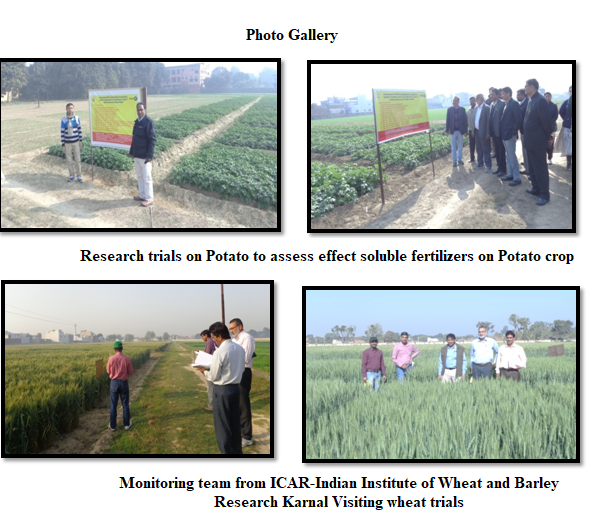
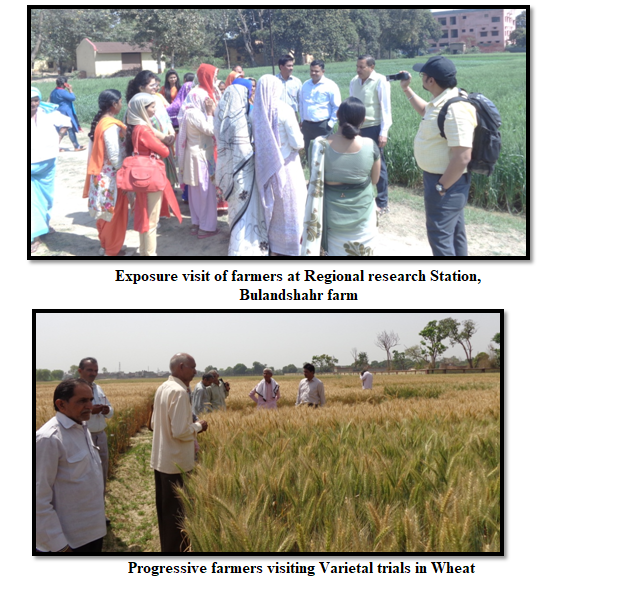
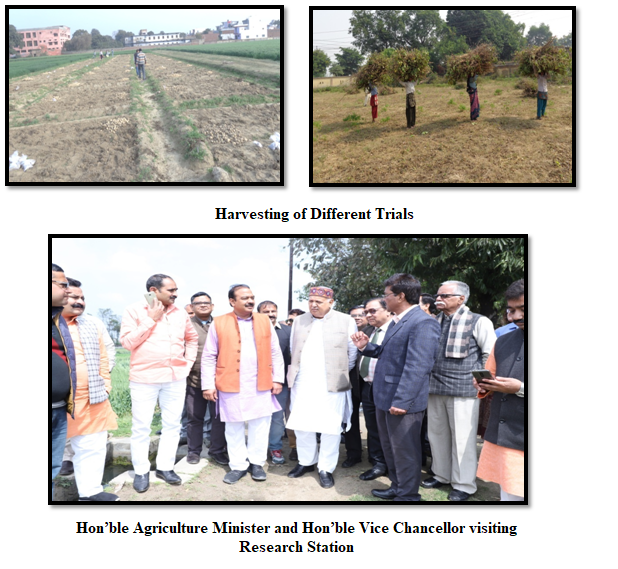

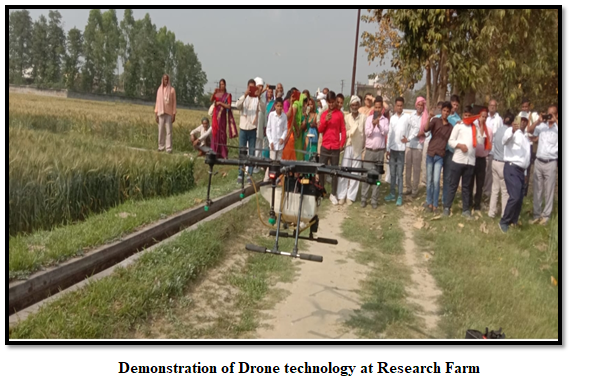
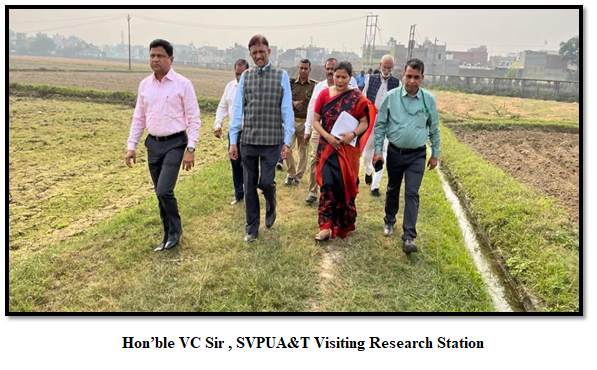
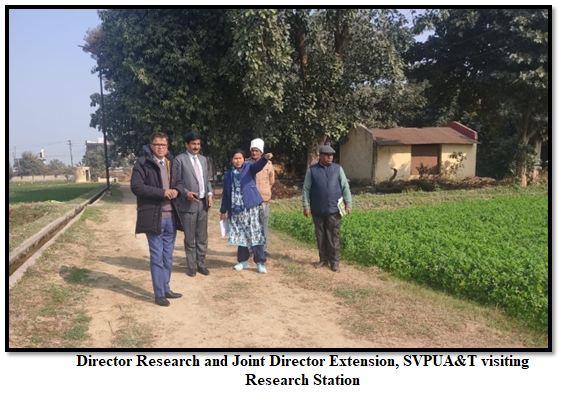
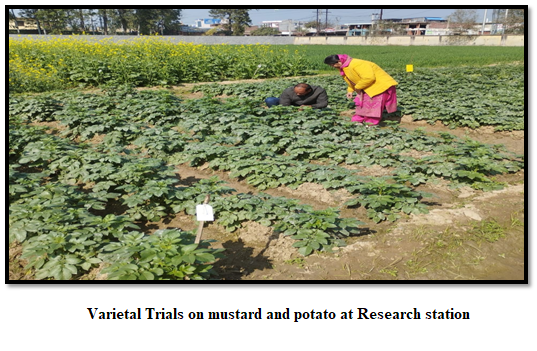
Rice Research Station, Nagina, Bijnor
- Overview
Research Station Nagina is one of the premier Rice Research Station of the country which was established by British Govt. after intensive survey of undivided India in 1921., situated in foot hills of great Himalaya at an altitude of 29O 28' North , and latitude 78o 32' East at 245 meter above mean sea level. This station has released 28 rice varieties for different eco-systems before green revaluation era and some of them are still under cultivation. An export quality rice variety Type -3, known as Dehraduni Basmati, is the first variety by which the quality rice export was started first time by our country India, was also released by this station. Another rice variety N-22, a drought resistant variety, is still being used as donor parent for drought resistant breeding.
- Research Mandate:
- Development of high yielding rice varieties.
- Collection and evaluation of rice germplasm.
- To test and verify the genetic material of crops (Rice and wheat) developed different parts of country through All India Coordinated Research Programmes.
- Quality seed production of rice and wheat.
- Standardization and evaluation of new agro techniques like resource conservation technology for the region.
- Diseases and pest management studies of various crops.
- Technologies Developed & Recommendations:
Varieties released:
Early N-22, N-27, N-32, A-64, T-136 and CH-10
Medium T-1, T-3 T-12 T-21 T-43 T-137 T-138 N-10B N-12 Ch-14 H-1627/1
Late T-5 T-9 T-17 T-22A T-23 T-26 T-36 T-56 T-79 T-88 T-100
- Under transplanted condition a new weedicide Flucetosulfuron was tested to quantify its dose . Flucetosulfuron 10 WG @ 25 g ai/ha as pre emergence was found optimum to check the weed flora as compared to its doses @20 g ai/ha and 30 g ai/ha.
- Among the rice varieties (Taraori basmati, Pusa Basmati 1, Pusa Sugandha 4 and Pusa Sugandha 5) under 3 establishment methods (direct seeding, drum seeding and transplanting), Drum seeding with Pusa Sugandha 5 was proven best in term of grain yield and most remunerative combination ( Rs 49 119.05) with highest values of B:C ratio (1.97) .
- On the basis of varietal screening of 7 basmati rice variety (Pusa Basmati 1509,Pusa Basmati 1560, Pusa Basmati-1460, Pusa Basmati 1121, Pusa Basmati -1, T-3 and Basmati 370 against rice stem borer , rice variety Pusa Basmati-1509 was found most resistant variety against stem borer with 15.75% dead hearts.
- Under dry direct and direct wet seeding conditions pre emergence application of herbicide Oxadiagryl @ 115g/ha at 2-3 DAS fb post emergence herbicide application Bispyribac sodium @ 300ml/ha at 25-30 DAS significantly reduce weed flora .
- Tested the efficacy and quantified the doses of new chemicals like Bispyribac sodium, flucetosulfuron under different establishment methods before their commercialization.
- Direct-seeded rice soils are often exposed to dry and wet conditions and difference in N dynamics and losses pathways often results in different fertilizer recoveries in aerobic soils. Under DSR the nitrogen scheduling of recommended dose should be at ¼ 2 WAS + ¼ 4 WAS + ¼ 6 WAS + ¼ 8 WAS as compared to ½ basal and remaining ¼ 4 WAS and ¼ at 6 WAS.
- It is recommended from the results of trials at Nagina that for better quality and yield of Basmati rice varieties Pusa Basmati 1509 should be transplanted after 15 july while PB-6 in second fortnight of june, late transplanting of these varieties increases broken grain and decreases basmati quality characters.
- Tested the efficacy and quantified the doses of new chemicals like Bispyribac sodium, flucetosulfuron under different establishment methods before their commercialization.
- Introduced drum seeder, mechanical transplanter, and LCC in the district.
Research Station Ujhani:
- Overview:-
An Agriculture farm of 34.85 acre at Ujhani has been transferred by the State Agriculture Department to G. B. Pant University of Agri. & Tech. Pantnagar to established a Zonal Research Station at Ujhani, Distt. – Budaun during December, 1986. The Research works were started after appointment of Chief Scientist and J.R.O. in Oct. ,1991 during NARP Phase II, Oct. 1989 to Sept. 30, 1993.
The Agro climatic conditions of this zone are dry and warm. Soils are mostly alluvial and neutral to moderately alkaline in reaction with low to medium in organic contents. Average rainfall of this region ranges from 650 mm to 1,600 mm and district Budaun receives minimum rainfall. Almost 90 per cent of rainfall is concentrated in four months from mid June to mid October which is variable and erratic. In this zone tube wells and canals are the major sources of irrigation but larger area is irrigated through tube wells except Bareilly district. Budaun has the least area under irrigation i.e. approx 44 per cent.
Soil Condition:
Soils are mostly alluvial and neutral to moderately alkaline in reaction. Sandy and Sandy loam soil are dominated textural class and having low in organic contents, low to medium in phosphorus & potash. Crops responded to S, Zn & B application.
Problem related to soil:-
(a). Alkaline (b).Soil erosion (c). Water logged
(iii). Area of Research farm (in hectare):- 16.51 ha.
(a). At Ujhani Campus:- 8.76 ha.
(b). At Kisarau Campus:- 7.75 ha.
(iv). Area under cultivation (in hectare):- 13.11ha.
(a). Ujhani :- 6.36 ha.
(b). Kisarau :- 6.75 ha.
- Research Mandate:- Oilseeds and Pulses
Thrust Area
- Development of high yielding varieties suitable to rain-fed farming for crops like groundnut, bajra, arhar, rape seed and mustard, gram, Urd and horticultural crops like guava, ber, bel, aonla, cucurbites,Potato, onion.
- To standardises agronomic practices which improves water use efficiencies in this area.
- To conduct research on various aspects of plant protection i.e. white, Grubs, termites , collar rot of groundnut, blights of potato & pulses, thrips of onion, aphids & white rust of Brassicae, fruit fly of vegetables and fruits. Various aspects of animal husbandry.
- To develop package of practice of different crops & suitable bajra based cropping systems for getting economic optimum yield.
- Evaluation of mustard varieties for timely and late sown conditions under Mid-Western Plain Zone of U.P. Wheat is generally sown late after harvest of rice and sugarcane based cropping systems. So, it is utmost essential to develop package of practices under late sown conditions.
- To study the deficiency and toxicity of macro and micro nutrients in the soils of this zone and Integrated Nutrient Management on different crops.
To find out best organic sources and doses of nutrient for cultivation of important crop of the zone. Foliar and basal application of micronutrients.
6. Activities with Photographs
a. Research Activities:

- 7. Significant Achievements:
(A) Variety Developed:
1. Nagina Vallabh Basmati-1 (IET 25404) : NVB-1 has been identified by state variety released committee of Uttar Pradesh for Basmati growing area of Uttar Pradesh. NVB-1 gives in UP 39.1 and 123% higher yield than the checks PB-1 and Taraori Basmati, respectively.NVB-1 flowered 102 days where as PB-1 and Taraori Basmati flowered 114-days and 119 days, respectively. It has per day productivity high as compared to check varieties.
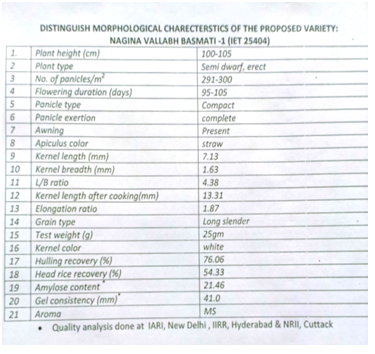
2. Nagina Vallabh Basmati-2: had been tested under State varietal Evaluation Trial.
3. Nagina Vallabh Rice-6: had been tested under State varietal Evaluation Trial.
(B) Rice Germplasm Maintained: 681 rice germplasm has been maintained at centre.
- 501 - Scented germplasm.
- 106 - non scented germplasm
- 35 - Blast resistant germplasm
- 39 - BLB resistant germplasm
- India's first non-GM herbicide-tolerant basmati rice varieties for DSR Pusa Basmati 1979 and Pusa Basmati 1985 – have been tested at the station for release which has been dedicated by hon’ble Prime Minister Narendra Modi to the nation on September 28 2021.
- In 2007, efficacy and dose of post emergence herbicide of Bispyribac sodium has been tested and quantified which is now major popular herbicide in the rice growing pockets of India.
- For dry direct seeded rice conditions combination of pre + post emergence herbicides has been tested, Oxadiagryl @ 115g/ha at 2-3 DAS fb post emergence herbicide application Bispyribac sodium @ 300ml/ha at 25-30 DAS has been identified which become most popular herbicide combination among direct seeded rice growers.
- Different Basmati rice varieties like Pusa Basmati 1460, Pusa Basmati 1509, Pusa Basmati 1401, Pusa Basmati 1637, Pusa Basmati 1692 etc have been evaluated in the station prior to their commercial release all the varieties covering maximum acreage among basmati rice growers.
- For timely sown condition, wheat varieties HD 2967, DBW-17, DBW 222, DBW 187, DBW 88, DPW 621-50 have been tested at the station and these varieties covering good area in NWPZ of UP.
- For late sown condition wheat varieties DBW16, DBW-71, DBW 90, HD 3059, PBW 590, WH 2021, WH 2124, DBW 173 have been tested at the station before their release and the varieties are popular among the sugarcane growing areas of this region where wheat is sown late after harvesting of sugarcane.
- To enhance nutritional security Bio-fortified varieties of wheat HPBW-01 & WB-02 have been tested prior to their release and popularized trough FLD’s allotted by IIWBR, karanal.
- 100 q Seed of wheat varieties HD 3086, HD 3226 and HD 2967 has been distributed to Schedule caste population of District Bijnor under SCSP project of IARI, New Delhi.
- 30 q Seed of Rice variety PB-1509 has been distributed to Schedule caste population of District Bijnor under SCSP project of IARI, New Delhi.
